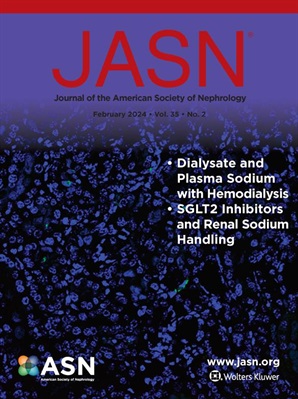胰岛素样生长因子结合蛋白 7 与镉诱发的肝肾纤维化
IF 10.3
1区 医学
Q1 UROLOGY & NEPHROLOGY
引用次数: 0
摘要
背景:慢性镉暴露可诱发肝肾纤维化的发生和发展;然而,其分子基础尚不清楚。胰岛素样生长因子结合蛋白7 (IGFBP7)不仅是急性肾损伤(AKI)的生物标志物,而且在促进肾损伤和炎症中发挥功能作用。AKI的异常修复导致肾纤维化和慢性肾脏疾病。IGFBP7也被报道为肝纤维化更敏感的生物标志物。然而,其在肝肾纤维化中的作用有待进一步研究。方法采用sigfbp7全基因敲除小鼠和条件敲除小鼠,研究IGFBP7在镉诱导的肝肾纤维化中的作用。然后,采用液相色谱-质谱,截断突变体,共免疫沉淀和微尺度热泳术来揭示下游机制。结果慢性镉暴露小鼠肾、肝组织中igfbp7表达显著升高。IGFBP7缺乏可减轻镉诱导的肝肾功能障碍和纤维化,而恢复IGFBP7缺乏小鼠的IGFBP7表达可复制肝肾纤维化。机制上,IGFBP7与α -烯醇化酶(ENO1)相互作用,抑制其泛素化和降解。ENO1的上调进一步促进了葡萄糖代谢重编程和乳酸积累。相反,乳酸积累通过组蛋白H3K18的乳酸化增强了IGFBP7的转录和表达。重要的是,靶向IGFBP7的治疗可显著改善镉诱导的肝肾纤维化。结论sigfbp7通过增强eno1驱动的异常糖酵解和乳酸积累,促进镉诱导的肝肾纤维化。本文章由计算机程序翻译,如有差异,请以英文原文为准。
Insulin-Like Growth Factor-Binding Protein 7 and Cadmium-Induced Hepatorenal Fibrosis.
BACKGROUND
Chronic cadmium exposure can induce the onset and progression of hepatorenal fibrosis; however, its molecular basis is unclear. Insulin-like growth factor-binding protein 7 (IGFBP7) is not only a biomarker of acute kidney injury (AKI), but also plays a functional role in promoting kidney injury and inflammation. Abnormal repair of AKI causes kidney fibrosis and chronic kidney disease. IGFBP7 has also been reported as a more sensitive biomarker for liver fibrosis. However, its role in hepatorenal fibrosis requires further investigation.
METHODS
IGFBP7 global and conditional knockout mice were used to determine the role of IGFBP7 in cadmium-induced hepatorenal fibrosis. Then, liquid chromatography-mass spectrometry, truncated mutants, co-immunoprecipitation, and microscale thermophoresis were employed to unravel the downstream mechanisms.
RESULTS
IGFBP7 expression was significantly elevated in kidney and liver tissues of mice subjected to chronic cadmium exposure. IGFBP7 deficiency attenuated cadmium-induced hepatorenal dysfunction and fibrosis, whereas restoration of IGFBP7 expression in IGFBP7-deficient mice reproduced hepatorenal fibrosis. Mechanistically, IGFBP7 interacted with alpha-enolase (ENO1) and inhibited its ubiquitination and degradation. Upregulated ENO1 further promoted glucose metabolic reprogramming and lactate accumulation. Conversely, lactate accumulation enhanced IGFBP7 transcription and expression through histone H3K18 lactylation. Importantly, therapy targeting IGFBP7 significantly ameliorated cadmium-induced hepatorenal fibrosis.
CONCLUSIONS
IGFBP7 promoted cadmium-induced hepatorenal fibrosis by enhancing ENO1-driven abnormal glycolysis and lactate accumulation.
求助全文
通过发布文献求助,成功后即可免费获取论文全文。
去求助
来源期刊
CiteScore
22.40
自引率
2.90%
发文量
492
审稿时长
3-8 weeks
期刊介绍:
The Journal of the American Society of Nephrology (JASN) stands as the preeminent kidney journal globally, offering an exceptional synthesis of cutting-edge basic research, clinical epidemiology, meta-analysis, and relevant editorial content. Representing a comprehensive resource, JASN encompasses clinical research, editorials distilling key findings, perspectives, and timely reviews.
Editorials are skillfully crafted to elucidate the essential insights of the parent article, while JASN actively encourages the submission of Letters to the Editor discussing recently published articles. The reviews featured in JASN are consistently erudite and comprehensive, providing thorough coverage of respective fields. Since its inception in July 1990, JASN has been a monthly publication.
JASN publishes original research reports and editorial content across a spectrum of basic and clinical science relevant to the broad discipline of nephrology. Topics covered include renal cell biology, developmental biology of the kidney, genetics of kidney disease, cell and transport physiology, hemodynamics and vascular regulation, mechanisms of blood pressure regulation, renal immunology, kidney pathology, pathophysiology of kidney diseases, nephrolithiasis, clinical nephrology (including dialysis and transplantation), and hypertension. Furthermore, articles addressing healthcare policy and care delivery issues relevant to nephrology are warmly welcomed.

 求助内容:
求助内容: 应助结果提醒方式:
应助结果提醒方式:


